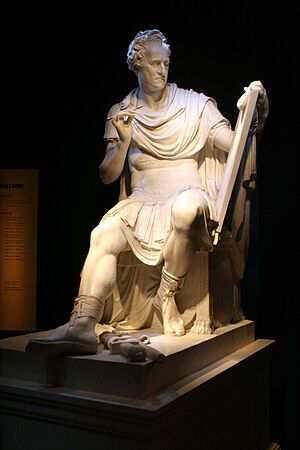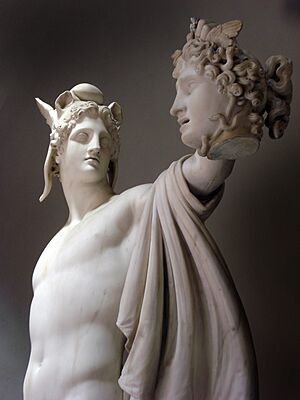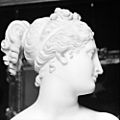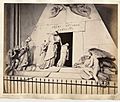Antonio Canova facts for kids
Quick facts for kids
Antonio Canova
|
|
|---|---|
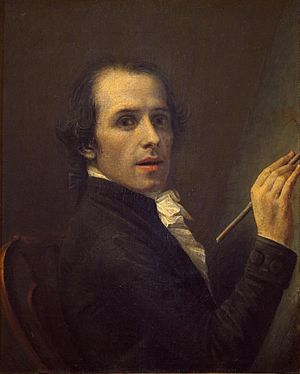
Self-portrait, 1792
|
|
| Born |
Antonio Canova
1 November 1757 Possagno, Republic of Venice
|
| Died | 13 October 1822 (aged 64) Venice, Lombardy–Venetia
|
| Nationality | Republic of Venice (1757–1798) Austria (territory ceded to Austria) (1798–1805) Kingdom of Italy (1805–1814) Austrian Empire (1814–1822) |
| Known for | Sculpture |
|
Notable work
|
|
| Movement | Neoclassicism |
Antonio Canova (born November 1, 1757 – died October 13, 1822) was a famous Italian Neoclassical sculptor. He was known for his amazing marble sculptures. Many people think he was the greatest Neoclassical artist.
Canova's sculptures were inspired by older styles like Baroque art and classical Greek and Roman art. His work was special because it avoided the overly dramatic feelings of Baroque art. It also didn't feel cold or fake like some classical art.
Contents
Life of Antonio Canova
Early Life in Possagno
Antonio Canova was born in 1757 in a city called Possagno, which was part of the Venetian Republic. His father, Pietro Canova, was a stonecutter. When Antonio was four years old, his father passed away.
A year later, his mother remarried. In 1762, Antonio went to live with his grandfather, Pasino Canova. His grandfather was a stonemason and owned a quarry. He was also a sculptor who made altars with statues. Pasino taught young Antonio about sculpting.
Before he was ten, Canova started making clay models and carving marble. When he was just nine, he made two small shrines from Carrara marble. You can still see these today! After these early works, he seemed to work constantly with his grandfather.
Learning in Venice
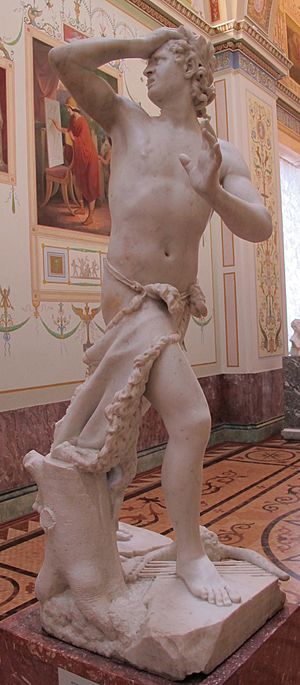
In 1770, Canova became an apprentice to a sculptor named Giuseppe Bernardi for two years. After that, he studied with Giovanni Ferrari. Then, he went to the Accademia di Belle Arti di Venezia (Academy of Fine Arts in Venice). He won many awards there. During this time, some local monks gave him his first workshop in a monastery.
A senator named Giovanni Falier asked Canova to create statues of Orpheus and Eurydice for his garden. Canova started these statues in 1775 and finished them by 1777. These pieces show the late Rococo style. When they were finished, they were shown in Piazza S. Marco. People loved them, and Canova became famous among the important people in Venice.
In 1779, Canova opened his own art studio. A rich official named Pietro Vettor Pisani asked Canova to create his first marble statue. It was a sculpture of Daedalus and Icarus. This statue was greatly admired at the yearly art fair. Canova was paid 100 gold coins for his work. The tools scattered at the base of the statue are a nod to the art of sculpture itself. Some people think Daedalus in the statue looks like Canova's grandfather, Pasino.
Moving to Rome
Canova arrived in Rome on December 28, 1780. Before he left Venice, his friends helped him get money from the Venetian government. He received 300 ducats a year for three years.
While in Rome, Canova spent time studying and drawing the works of the famous artist Michelangelo.
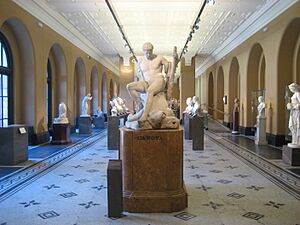
In 1781, Girolamo Zulian, who was the Venetian ambassador to Rome, hired Canova. He asked Canova to sculpt Theseus and the Minotaur. Zulian helped Canova become very famous. He even let Canova use some rooms in his palace as a studio. The statue shows the hero Theseus sitting on the dead body of the Minotaur. When people first saw it, they thought it was an ancient Greek sculpture. They were surprised to learn it was a new work! This highly praised sculpture is now in the Victoria & Albert Museum in London.
Between 1783 and 1787, Canova created a monument for Pope Clement XIV for the Church of Santi Apostoli. This monument made Canova known as the most important living artist.
In 1792, he finished another monument for Pope Clement XIII in St. Peter's Basilica. Canova made its design fit well with the older monuments in the church.
In 1797, he traveled to Vienna. But a year later, in 1798, he went back to Possagno for a year.
Working for Emperors and Kings
By 1800, Canova was the most famous artist in Europe. He made sure people knew about his work by publishing pictures of his sculptures. He also had marble copies made from his plaster models. He became so successful that people from all over Europe wanted his art. This included France, England, Russia, Poland, Austria, and Holland. Many royal families and important people became his supporters.
Among his most famous supporters were Napoleon and his family. Canova created many works for them between 1803 and 1809. The most famous ones were Napoleon as Mars the Peacemaker and Venus Victrix, which was a statue of Napoleon's sister, Pauline Bonaparte.
The idea for Napoleon as Mars the Peacemaker started when Canova was asked to make a bust of Napoleon in 1802. The statue began in 1803. Napoleon wanted to be shown in a French general's uniform. But Canova said no. He insisted on showing Napoleon like Mars, the Roman god of war. The statue was finished in 1806. In 1815, the original statue went to the Duke of Wellington after his victory against Napoleon at Waterloo.
Venus Victrix was first planned as a robed statue of Pauline Borghese as Diana. But Pauline told Canova to make it a Venus instead. This artwork was not meant for everyone to see.
Other works for Napoleon's family included a bust of Napoleon, a statue of Napoleon's mother, and Marie Louise as Concordia.
In 1802, Canova was given the important job of 'Inspector-General of Ancient Art in the Papal State'. This job was once held by the famous artist Raphael. One of his tasks was to help restore the Appian Way, an ancient Roman road. In 1808, Canova became a member of the Royal Netherlands Academy of Arts and Sciences.
In 1814, he started his famous work, The Three Graces.
In 1815, he was named 'Minister Plenipotentiary of the Pope'. His job was to get back many artworks that Napoleon had taken to Paris.
Also in 1815, he visited London. He met with Benjamin Haydon there. Canova advised that the Elgin Marbles should be bought by the British Museum. He also asked for plaster copies to be sent to Florence.
Returning to Italy
In 1816, Canova returned to Rome with some of the art that Napoleon had taken. He received many honors for this. The Pope made him President of the Accademia di San Luca. He was also given the title of Marquis of Ischia and a yearly payment.
In 1819, he started and finished his sculpture Venus Italica. This statue was made to replace the famous Venus de' Medici.
Canova had an idea in 1814 to build a statue of Religion for St. Peter's Basilica. But his idea was not accepted. So, Canova decided to build his own temple to put it in. This project became the Tempio Canoviano. Canova designed, paid for, and partly built this church himself. It was meant to show Canova's strong religious faith. The building's design was a mix of the Parthenon and the Pantheon. On July 11, 1819, Canova laid the first stone. He was dressed in a special uniform and wore all his medals. The church first opened in 1830 and was finally finished in 1836. After starting the church, Canova went back to Rome. But every autumn, he would visit Possagno to guide the workers.
During the time between starting the church and his death, he created some of his most striking works. These included the group Mars and Venus, a huge statue of Pius VI, the Pietà, St John, and a large bust of his friend, Count Cicognara.
In 1820, he made a statue of George Washington for the state of North Carolina. The sculptor used a marble bust of Washington by Giuseppe Ceracchi as a model. The statue was delivered on December 24, 1821. Sadly, the statue and the building where it was displayed were destroyed by fire in 1831. A plaster copy was sent by the king of Italy in 1910. It is now at the North Carolina Museum of History. A marble copy was made in 1970 and is now in the capitol building.
In 1822, Canova traveled to Naples to oversee the making of wax molds for a statue of Ferdinand VII on horseback. This trip was bad for his health. But he soon felt well enough to return to Rome. From there, he went to Venice. However, on October 13, 1822, he died there at the age of 64. He never married, so his family name ended, except through his stepbrothers.
On October 12, 1822, Canova told his brother to use all his money to finish the Tempio in Possagno.
On October 25, 1822, his body was placed in the Tempio Canoviano. His heart was buried in the Basilica di Santa Maria Gloriosa dei Frari in Venice. His right hand was kept in a vase at the Accademia di Belle Arti di Venezia.
His memorial service was so grand that it was like the ceremony held for Michelangelo in Florence in 1564.
In 1826, Giovanni Battista Sartori sold Canova's studio in Rome. He took all the plaster models and sculptures to Possagno. They were then placed in the Tempio Canoviano.
Famous Works
Here are some of Antonio Canova's most famous sculptures:
Psyche Revived by Cupid's Kiss (1787)
Psyche Revived by Cupid's Kiss was ordered in 1787 by Colonel John Campbell. It is considered a masterpiece of Neoclassical sculpture. It shows the mythological lovers, Cupid and Psyche, at a very emotional moment. Cupid is waking up the lifeless Psyche with a kiss.
Napoleon as Mars the Peacemaker (1802–1806)
The idea for Napoleon as Mars the Peacemaker began when Canova was asked to make a bust of Napoleon in 1802. The statue was started in 1802. Napoleon wanted to be shown in a French general's uniform. But Canova refused. He insisted on showing Napoleon like Mars, the Roman god of War. It was finished in 1806. In 1815, the original statue went to the Duke of Wellington after his victory against Napoleon at Waterloo.
Perseus Triumphant (1804–1806)
Perseus Triumphant, also called Perseus with the Head of Medusa, was a statue ordered by Onorato Duveyriez. It shows the Greek hero Perseus after he defeated the Gorgon Medusa.
The statue was inspired by the famous ancient Greek sculptures, the Apollo Belvedere and the Medusa Rondanini.
After his campaigns in Italy in 1796, Napoleon took the Apollo Belvedere to Paris. While it was gone, Pope Pius VII bought Canova's Perseus Triumphant. He placed it on the pedestal where the Apollo used to be. The statue was so popular that when the Apollo was returned, Perseus stayed as a companion piece.
A copy of this statue was made for a Polish countess. It is now in the Metropolitan Museum of Art in New York City.
Venus Victrix (1805–1808)
Venus Victrix is one of Canova's most famous works. Canova first wanted to show Pauline Borghese as a robed Diana. But Pauline insisted on being shown as Venus. This artwork was not meant for the public to see.
The Three Graces (1814–1817)
John Russell, the 6th Duke of Bedford, ordered a version of this famous sculpture. He had visited Canova's studio in Rome in 1814. He was very impressed by a carving of the Graces that Canova had made for Empress Josephine. When the Empress died, he tried to buy it, but her son claimed it.
The Duke then ordered another version for himself. Canova started sculpting it in 1814 and finished it in 1817. In 1819, it was placed at the Duke's home in Woburn Abbey. Canova even traveled to England to make sure it was set up correctly. He chose for it to be displayed on a special base that could rotate. This version is now owned by both the Victoria and Albert Museum and the National Galleries of Scotland. It is shown at each museum at different times.
How Canova Created His Art
Canova had a special way of working. He mixed Greek and Roman art styles with new ideas from Romanticism. This created a new kind of Neoclassicism. Canova's sculptures can be put into three groups: heroic works, graceful works, and monuments for tombs. In all of them, Canova wanted to compete with the famous classical statues of the past.
Canova did not take students. But he hired workers to carve the first shape from the marble. Canova focused on the first idea and the final carving of the marble. His workers used a detailed system to copy the plaster model into the marble block. They would leave a thin layer of marble over the whole statue. This allowed Canova to focus on the statue's surface.
While he worked, he had people read to him from books about literature and history.
The Final Touch
In the late 1700s, it became popular to view art galleries at night by torchlight. Canova loved this idea. He would show his artworks in his studio by candlelight. He would finish his statues with special tools by candlelight. This helped to soften the lines between different parts of the sculpture. After some more carving, he would rub the statue with pumice stone. Sometimes this took weeks or even months. If that wasn't enough, he would use other materials like tripoli and lead.
Then, he would put a special chemical mix on the skin parts of the statue. This made the skin look lighter. His friends said he never used any harsh acids in this process.
Canova's Legacy
After Canova died, artists of the Romantic period didn't talk about him much. But now, people are starting to appreciate his work again. An art historian named Giuseppe Pavanello wrote in 1996 that Canova's art is important. It connects the old styles of art with the new, experimental art of modern times.
Canova used a lot of his money to help young students. He also sent wealthy people to support other sculptors who were struggling.
He was given many honors and awards during his life.
Many of his works, drawings, and writings are kept in the Sala Canoviana at the Museo Civico of Bassano del Grappa. Other works, including plaster models, are at the Museo Canoviano in Asolo.
In 2018, a crater on the planet Mercury was named in his honor.
Places Named After Canova
- Canova, South Dakota
- Via Antonio Canova, a street in Treviso
- Aeroporto di Treviso A. Canova (Treviso Airport)
- The Museo Canova in Possagno
- Tempio Canoviano, a church in Possagno
Gallery
-
Terpsichore Lyran (Muse of Lyric Poetry).
-
Monumental tomb of Vittorio Alfieri, Florence, 1810.
See also
 In Spanish: Antonio Canova para niños
In Spanish: Antonio Canova para niños



